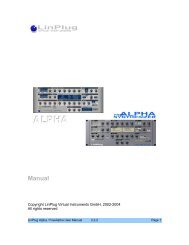Alpha Series User Manual - LinPlug Virtual Instruments
Alpha Series User Manual - LinPlug Virtual Instruments
Alpha Series User Manual - LinPlug Virtual Instruments
You also want an ePaper? Increase the reach of your titles
YUMPU automatically turns print PDFs into web optimized ePapers that Google loves.
Overview<br />
There are multiple versions of the <strong>Alpha</strong> synthesizer available: the full <strong>Alpha</strong> 3, a<br />
couple of custom <strong>Alpha</strong> synthesizers with a somewhat reduced featureset and the<br />
<strong>Alpha</strong>FREE which is publicly available but has the fewest features. See Appendix E<br />
for the differences between the <strong>Alpha</strong> and the <strong>Alpha</strong>FREE. This manual describes<br />
the <strong>Alpha</strong> so some parts may not be applicable to the custom versions of <strong>Alpha</strong> and<br />
the <strong>Alpha</strong>FREE.<br />
The <strong>Alpha</strong> synthesizer is a monotimbral, 32 note-polyphonic AU and VST analoguestyle<br />
synthesizer with some extraordinary features. The synthesizer is based upon a<br />
classic subtractive design and includes three oscillator modules, a filter module,<br />
envelope and LFO modules, a chorus effect module and an easy-to-use and<br />
powerful Modulation Matrix.<br />
The structure of the <strong>Alpha</strong> synthesizer can be divided into 6 sections: Oscillator,<br />
Filter, Amplifier, Modulation (Matrix, LFOs and Glide), Chorus and Master.<br />
Audio signals are generated by an oscillator that gets pitch information from the<br />
synthesizer's MIDI input. The MIDI input is automatically connected to MIDI output of<br />
the host software. The <strong>Alpha</strong> receives MIDI on all channels simultaneously.<br />
The <strong>Alpha</strong> contains three oscillators. Each oscillator's pitch, amplitude and symmetry<br />
can be modulated using the Modulation Matrix (Noise can be only modulated in<br />
amplitude).<br />
The output of all oscillators is mixed and routed to the Filter section. The filter<br />
modifies the harmonic spectrum of the oscillator's output mix and has its own<br />
dedicated envelope for controlling the filter cutoff parameter.<br />
The output of the Filter section is then sent to the Chorus section.<br />
The audio outputs of the <strong>Alpha</strong> are automatically connected to the input of your host<br />
software's mixer. Here you can set the pan position of the <strong>Alpha</strong>'s output.<br />
At various points throughout the signal path you can modulate the signal using either<br />
envelopes, LFOs or MIDI controllers. The <strong>Alpha</strong> contains 2 independent envelopes<br />
and three LFOs that can be routed to any available modulation destination.<br />
<strong>LinPlug</strong> <strong>Alpha</strong> <strong>Series</strong> <strong>User</strong> <strong>Manual</strong> 3.0 Page 6












